A deep mark in the french collective unconscious
« The Chernobyl cloud has stopped at the french borders« ! The broadcast on television and in newspapers of weather maps from April 29 to May 1 suggested that France was escaping the radioactive cloud, due to high pressures in the Azores and favorable winds …
Was this mythical phrase really spoken? Whatever! It remained deeply rooted in people’s minds, despite the many defamation actions brought by Professor Pierre Pellerin (1923-2013), director at the time of the SPCRI (Central Service for Protection against Ionizing Radiation). Judgments in his favor did nothing.
In 2006, around 500 plaintiffs filed for civil action, accusing the SCPRI and its director of having misled “the public authority and the populations about risks involved”. The SCPRI would have concealed, by producing maps based on departmental averages, high concentrations of dangerous radioactive iodine in areas with high rainfall where contamination swould have approached, from April to June 1986, those of territories near Chernobyl. The scientific community mobilized to support the SCPRI director in charge. According to a 1997 IRSN report taking into account the level of radioactive fallout, doses to the thyroid in France were 100 to 300 times lower than those in Ukraine and Belarus.
The SCPRI denied having said that cloud stopped at the borders, but its presentation was soothing. He warns government authorities and news agencies of the arrival of the cloud on the night of April 29 to 30. But a second press release, the same April 30, reported a « slight increase in atmospheric radioactivity, not significant for public health. » Then on May 1 and 2, the SCPRI estimated that given the quantities of radioelements in the « cloud » and the levels of contamination « neither the current situation, nor its subsequent development justifies any health countermeasure whatsoever ».
IRSN video (2005) reconstructing the dispersion of the radioactive cloud over Europe. The reconstitution is in agreement with the measured cesium deposits.
To avoid worrying, should one be too reassuring ? France owing to its geographical position far from Chernobyl has been one of the least affected nations in Europe. The soothing message from the authorities was justified , considering average contaminations, but overlooked the existence of local « leopard spots » with higher local contaminations. How would public opinion have reacted to more truthful information ? What is certain is that to avoid worrying, the authorities discredited themselves. Were there any casualties? If so, they were few in number and it was scientifically impossble to identify who they were.
What is certain is that for not wanting to worry, the authorities have discredited themselves. Were there any casualties? If so, they are few in number and we cannot scientifically demonstrate who they are.
An history of the unfolding and course of the cloud
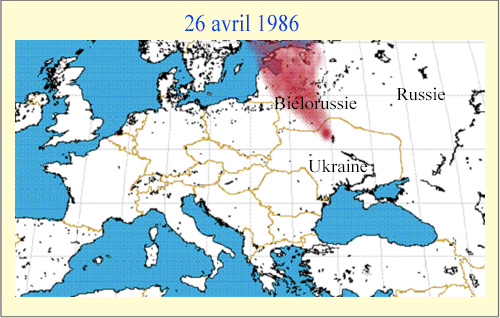
April 26th – the accident day
On April 26, 1986, the day of the accident, a wind of 30 to 40 km/h carried the plume of radioactive dust towards northern Ukraine and Belarus. The plume harmfulness was increased by the presence of extremely short-lived radioelements. The surroundings of the plant were highly contaminated by the fallout on the ground of the heaviest dust particles.
© IRSN
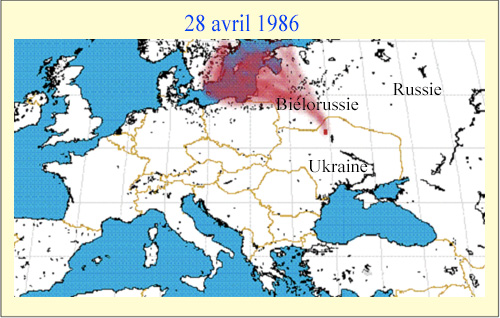
April 28th – 2 days later
The fire in the reactor sustains the émission of radioactive particles. The initial plume continues its course northward and after April 27 westward. The cloud, freed from heavy radioelements that contaminated the surroundings of the plant, contains volatile or mobile radioelements such as iodine, cesium and strontium.
© IRSN
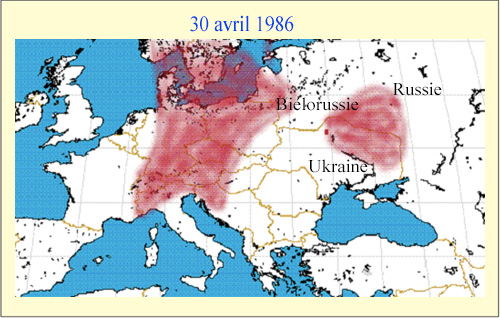
April 30th – 4 days later
Arrived over the Scandinavian countries where abundant rains were the source of heavy contamination on the ground, the initial plume fell back towards the east before bringing the radioactive pollutants towards the south. The releases of April 27, pushed west, approach France from the east and the south. They will fly over the territory between April 30 and May 5.
© IRSN
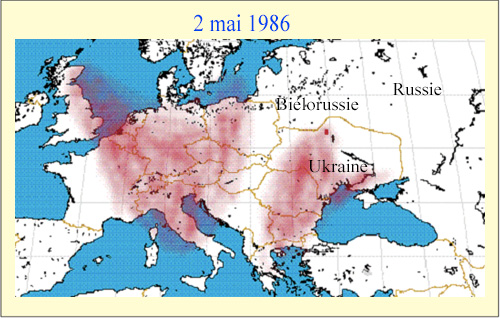
May 2 sd …
Masses of contaminated air moved westward. Heavy rains or the interception of the cloud by mountains brought back part of the radioactivity to the ground, causing locally high contamination, particularly in Austria. In France, parts of the Vosges, the Jura, the Southern Alps and Corsica were the most affected.
©IRSN
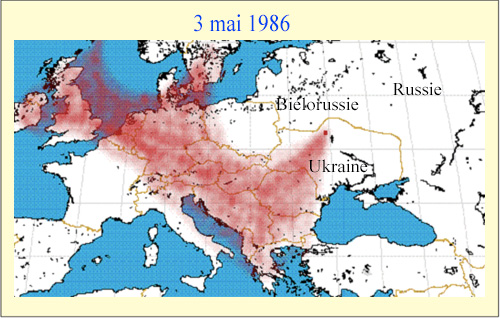
May 3d –
A week after the accident, the fire is still raging. As the wind has turned, the new radioactive material released is heading southwest towards the Balkans and Greece, as the initial plume continues to move west. The nature of emissions has evolved, with the most radioactive very short-lived elements being less present.
© IRSN
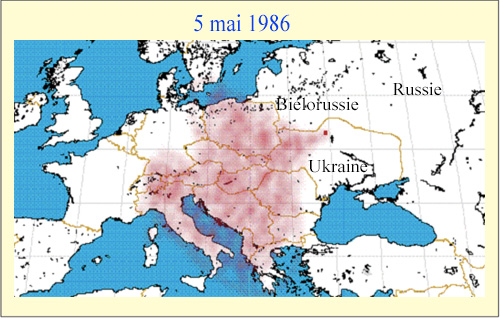
May 5th –
The cloud sets off again towards the east, the south, leaving France. May 5 is the date when the releases from Chernobyl stopped. The most harmful radioelement is iodine-131 due to its mobility and absorption by the thyroid (it will take about 3 months for its activity to be divided by 1000). In the long term, the main contamination on the ground is due to cesium-137.
© IRSN
Other articles on the subject « Chernobyl accident »
Chernobyl Circumstances
An explosion followed by a graphite fire In 1986 the Ukrainian Chernobyl plant had 4 RBMK reactor[...]
Chernobyl Liquidators
A heavy toll paid by firefighters and liquidators: The magnitude of the disaster took the Soviet [...]
Radioactive Releases
Radioactive releases and contaminations at Chernobyl The explosion of the reactor led to the disp[...]
Chernobyl Exclusion Zone
A no man’s land turned into a natural reserve ? On April 27th, 1986, one day after the expl[...]
Chernobyl Health Effects
Chernobyl: A toll still impossible to quantify It is difficult to reach an approached assessment [...]
Chernobyl Iodine 131
A dangerous radioelement during the first weeks Iodine-131 is the most feared fission product whe[...]
Chernobyl Caesium-137
The accident long term legacy More than twenty years after the Chernobyl accident, attention focu[...]
Chernobyl Today
The Chernobyl Site Over 30 Years Later On December 15, 2000, the Ukrainian government, in accorda[...]